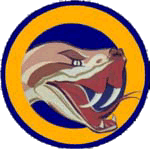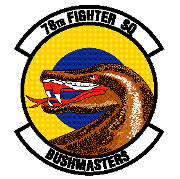|
Major Jim Tapp is in the process of writing a history of the 78th and has graciously allowed me to present some of that history on this page. No part of this text may be reproduced without the permission of Major Tapp The 78th Aero Squadron was activated at Waco, Texas on February 28, 1918 and moved to Hicks Field, Texas on the same date. On July 23, 1918 it was redesignated as Squadron A at Taliaferro Field, Texas. With other Squadrons it formed the Flying School Detachment at that field on November 3, 1918. It was reconstituted and consolidated with the 78th Observation Squadron and designated the 78th Pursuit Squadron on May 8,1929.and assigned to the 20TH Pursuit Group. It was activated as the 78th Pursuit Squadron, 16th Pursuit Group on April 1, 1930 at France Field in the Canal Zone. It moved to Albrook Field, CZ, October 15, 1932 It became inactive September 1 1937. While at Albrook it flew P-12s. It was at Albrook that the Bushmaster snake head was adopted as its emblem. The Bushmaster is a much feared poisonous snake in Central America. The Squadron was reactivated at Wheeler Field, T. H. On February 1, 1940 with Captain D. W. Jenkins as its commander and Joseph A. Messaris was First Sergeant. The first pilot was assigned March 1, 1940 and the first aircraft were a handful of the open cockpit low wing Boeing P- 26 Pea Shooters and the more modern radial engined low wing Curtis Wright P-36 Hawks along with 2 OA-10s and 2 North American AT-6 Harvard advanced trainers.. Captain Jenkins was followed by Captain A. J. Hanna. Under him the number of pilots grew to 26. The first fatality occurred on August 29, 1940 when Lt. Farris failed to return from a mission. On January 6, 1941 Lt. Weigel was killed as a result of an air collision with Lt. Hanes. Lt. Hanes successfully bailed out. On April 30,1941 W. P. Fisher became commander and he was followed by W. R. Clingerman Jr. Master Sergeant Richey became First Sergeant in June 1941. The build up in forces and aircraft continued and the obsolete aircraft were replaced with the Curtis Wright P-40Bs. The P-40B had a 12 Cylinder V-12 Allison liquid cooled engine. It had two M-2 50 caliber machine guns accessible from the cockpit. These guns fired through the propeller. It also had two 30 caliber machine guns in each wing. Captain Clingerman was in command on December 7, 1941 when the Squadron and other units of the 14th Pursuit Wing were attacked at Wheeler Field. All of the Squadron's 17 P-40B aircraft were either destroyed or damaged. Sergeant Morris Stacy was killed by a strafing Japanese aircraft and Corporal Vincent N. Horan was killed by a bomb fragment. As a consequence of an exceptional effort by the squadron people four P-40s were repaired and flyable on December 8th. Many incidents, humorous in hindsight, occurred on those eventful days. Ken Sweet and were on guard duty on the flight line. They had been issued the same five old 30.06 rounds that had been used for a long time. Ken said the bullets were loose in the shell casing. They fired at the Jap planes but the rounds barely had enough energy left in them to push the projectiles out of the barrel. With the five rounds expended they tossed the rifles aside and Clyde Mortensen says that he was on the way to the flight line with Capt. Clingerman who expounded "Someone is really going to catch hell for this". The squadron was then dispersed at Wheeler and 30 men assigned to ground defense. The rest of the squadron was put to work rehabilitating the buildings and grounds. On February 1, 1942 the squadron was moved to Kaneohe Naval Air Station and equipped with the mid-engined Allison powered Bell P-39D Aircobras. The P-39D had the same machine gun configuration as the P-40B but also had a Browning 37 mm cannon that fired through the propeller hub. The move was part of the overall effort to disperse all pursuit aircraft away from Wheeler Field. Never again would the command be caught off guard All aircraft were henceforth dispersed, bunkered, and covered with camouflage netting when feasible. The major maintenance on the aircraft was performed at night resulting in very high (over 98%) in commission rates. Pilots for 12 aircraft performed ready room alerts each morning and evening and all day alerts every third day. At Kaneohe the 78th aircraft were kept in bunkers along the North side of the airstrip or mat near the West or normal take off end. The bunkers had vertical concrete walls with some randomness in the placement of the openings to prevent presenting a multiple set of targets to enemy strafers. Camouflage netting was strung across the top of the bunkers. An example of the sturdiness of their construction occurred one night when the carrier air group was practicing night carrier landings. One Grumman F4F was given a wave off by the Landing Duty Officer and broke to the left as required and ran smack into one of the bunkers. By some miracle the pilot although badly injured survived. The bunker on the other hand hardly had a scratch on it. The bunkers held four P-40s. The fit was kind of tight. The fuel trucks couldn't conveniently get in to service the aircraft so two sets of 55 gallon drums were used for this purpose. The fuel of course had to be pumped by hand. When the aircraft went out on a mission the fuel truck would fill the barrels. This of course also provided a better defensive posture as well. The air group fighter squadron when aboard the station was located at the extreme West end of the mat with the 78th next door. The operations, engineering, armament, supply etc shacks were all in the area as well as the mess hall. The ready room and operations shack were closest to the runway and right next to each other. The front end of the ready room had some chairs and a table and the back end had double-decker bunks for the pilots to use on the early morning alerts. Above the door was a bell and a bank of four lights. These were red, white, blue and yellow to correspond to the flight colors. When the operations clerk got a scramble call from Fighter Control he would switch on the bell and the lights for the flight of flights that were next up. The assistant operations clerk would step out on the porch of the shack and blow the charge call on his bugle. All this activity set off an abrupt surge in activity. The pilots would take off on the run for the nearby bunkers or the carry all and the crew chiefs who had been sitting in the cockpits and keeping the engines warm would start the engines and the get out on the wing where he would hold the pilots parachute harness at ready for the pilot to get into. The buckling in was done quickly and the aircraft departed the bunkers for the runway or mat. The Kaneohe mat was so wide that four aircraft could comfortably take off at a time. Fighter Control started a clock when our ops clerk took the call and would stop it when the leader called in airborne on the radio. They would give the squadrons a monthly summary of these times. The 78th squadron consistently got in the air in under three minutes time and consistently led the command. Kaneohe also was a better night flying field than most of the other squadrons enjoyed. As a consequence we were given a lot of the early morning intercepts and dawn combat air patrols (CAP). Our scrambles for these usually occurred in pitch black darkness particularly with the stringent blackout conditions that were imposed on everyone. The CAPs always included all three flights of the tactical squadron. It was a little scary to arrive at your bunker with all four props spinning but with only the confused mixture of the dimmed red, green and white lights showing. You had to be very careful and make sure that you became properly oriented to prevent running into a prop. If you had been asleep in one of the ready room bunks when the scramble was sounded it only took one close call to give you insomnia in the ready room. On the days when the squadron was not on an all day alert training missions would be flown. The morning alert would usually be over with around 0800 depending on the time of the year. Most morning alerts were CAP flights or intercepts. These were followed by breakfast in the mess. The training schedule kicked in at that time. There were usually two morning missions and one in the afternoon. Their content depended on the level of training that the pilots were at. There was very little influx of new pilots into the command until late July 1942. The top leaders had decided that the European Theater would receive priority because of the dire situation faced there. A dire situation developed in the South West Pacific too. The first influx to the 7th Fighter Command were pilots who had volunteered for immediate combat in fighters. These people were in the later stages of their training at the Advanced Flying Schools. They were graduated two weeks early and sent to the 311th Fighter Squadron, 58th Fighter Group at Dale Mabry Field, Tallahassee, Florida. Other pilots joined them there. An intensive but not too effect flight schedule was the order of the day. After a month they were loaded aboard a train and sent to San Francisco where they set sail for Pearl Harbor aboard the USS Republic. Carrier Air Group 5 was on the ship as well. Upon arrival at Pearl the people were split up and sent out to the various squadrons of the 7th Fighter Command. The 78th Squadron at Kaneohe NAS received 8 of this first contingent of new pilots. They were mostly people from the Gulf Coast Training Command class of 42F. They were Simonson, Tapp, Tennant, Wells, Wolf. As it turned out they relieved experienced pilots from the Squadron who were mainly sent to 5th Air Force in New Guinea and one to the Eighth Air Force in Europe. Some of the pilots were only with the squadron briefly and then sent on to New Guinea and some to Midway to join the 73rd Fighter Squadron which was assigned to Marine Air Group 22. During the Battle of Midway VMF 222 was pretty well decimated their Brewster Buffalos being no match against the Japanese carrier fighters. The 73rd was loaded aboard the Saratoga and brought part way to Midway. The squadron flew off the carrier and landed on East Island where MAG 22 was located. Shortly after the arrival of the arrival of the 42F pilots a contingent of pilots from the West Coast Training Command Class of 42G joined in the command. The 78th got its share of this class which was followed shortly by another 42G group this from the Gulf Coast Training Command. The two training commands were on slightly different schedules. At the same time the 78th Squadron began receiving P-40Ks as replacements for the old P-40Bs. The K had a little more power but more importantly had three 50 caliber machine guns in each wing which greatly increased the fire power. to be continued.......... |
 ...
...

